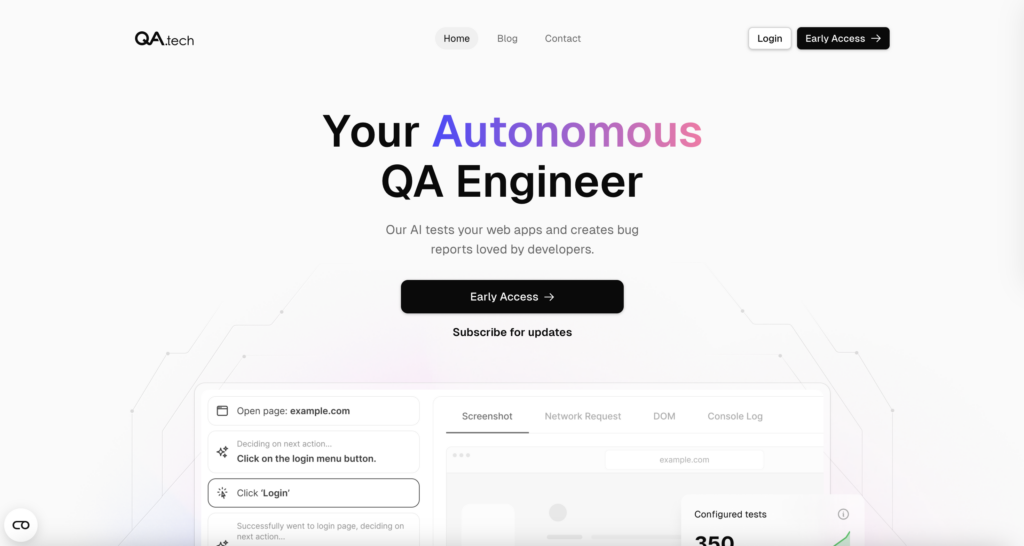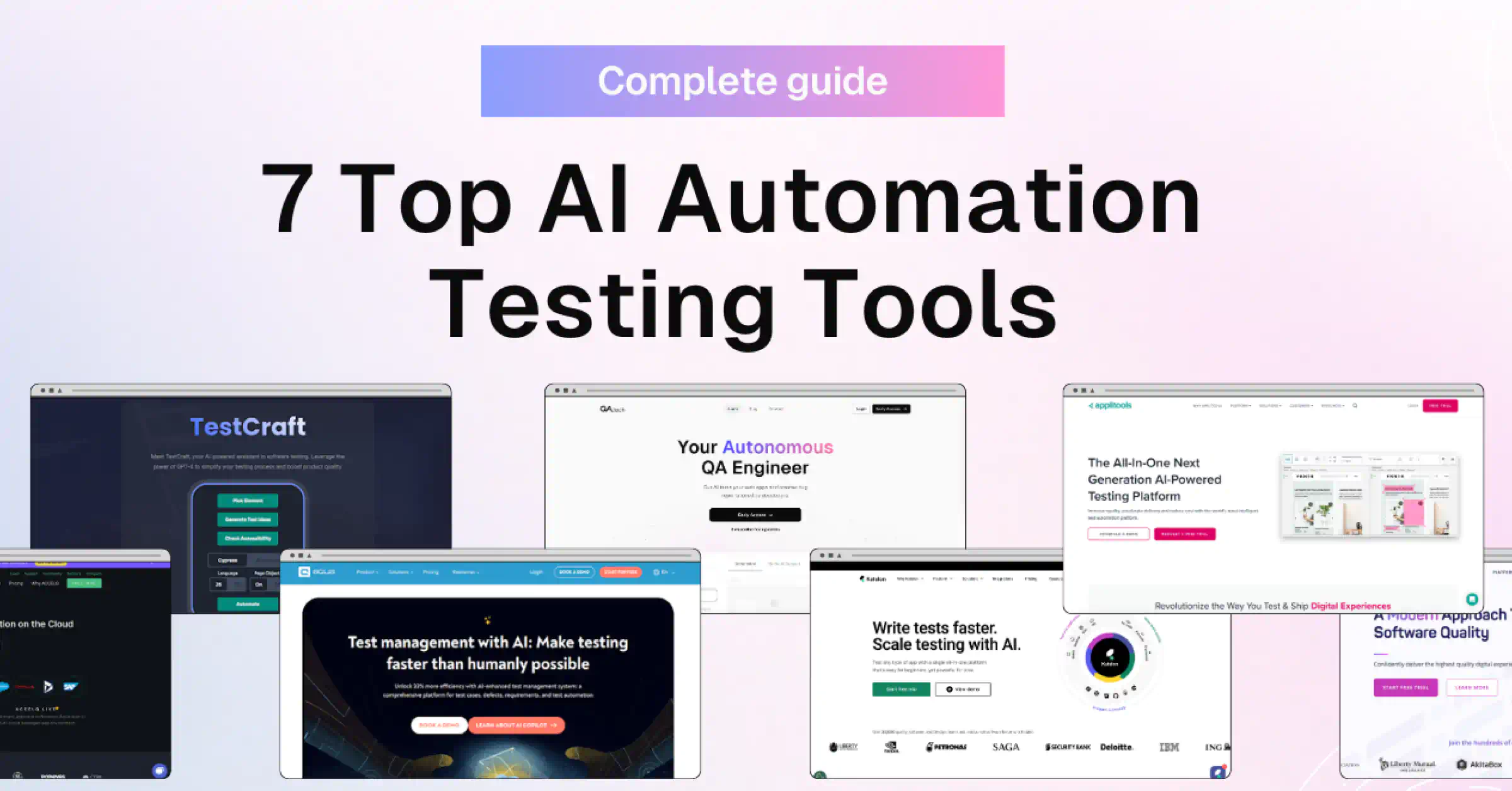As software development becomes more complex, product teams are seeking easier ways to deliver high-quality software products quickly and efficiently. As a result, software testers are increasingly turning to AI automation testing tools.
These solutions allow them to streamline testing processes, improve accuracy, and accelerate time-to-market. We’ll discuss the following AI automation testing tools:
- QA.Tech – Top recommendation for comprehensive AI QA testing
- Katalon – Recommended QA testing tool for ease of use
- TestCraft – Recommended for superior defect detection
- Applitools – Recommended for excellent user experience
- Mabl – Scalable and adaptable AI testing tool
- ACCELQ – Recommended for accelerated QA testing
- Aqua ALM – Recommended for integrating with your ALM
By the end, you’ll know what these tools can offer you, how they work, and how to select the right one for your project.
Get ready to unlock the potential of AI in quality assurance (QA).
Why Do Product Teams Need AI Automation Testing Tools?
AI-based test automation tools can help software testers in the following ways:
1. Autonomous Test Case Generation
AI and machine learning technologies have ushered in a new approach to QA known as autonomous test case generation. This process involves generating test cases automatically without human intervention or manual scripting.
Intelligent algorithms analyze application requirements, codebase, user stories, or historical testing data to automatically create test scenarios, inputs, and expected outputs. The autonomous testing advantage reduces the manual effort required for test case creation
2. Test Execution
AI-based test automation tools also help in executing tests on software. They replicate user actions like button clicks, data entry, and screen navigation. This quality ensures that the software behaves as expected from a user’s perspective.
Prioritization is another aspect of test execution these tools handle. They dynamically adjust test execution schedules to focus on crucial areas of the application.
3. Conducting Visual Tests
AI software testing tools can conduct visual tests to identify irregularities in application layout, design, and appearance. They compare screenshots of application interfaces against baseline images to detect visual defects.
AI-based visual testing tools can also detect dynamic changes in the application interface, such as pop-up dialogs or dynamic content. These tools ensure consistent user experiences across different devices and screen sizes.
4. Predictive Analytics
AI powered test automation tools use machine learning algorithms to analyze historical test results and identify patterns that indicate potential defects or performance issues. With these tools, product teams can easily prioritize testing efforts, allocate resources effectively, and mitigate risks before they affect end users.
5. Better Regression Testing
AI automation testing tools make regression testing easier by running test cases again automatically to check for issues after code updates. They ensure that new features or updates don’t cause problems with existing ones.
These tools make it possible for product teams to keep their software working well and being reliable, even as the code gets bigger and changes over time.
Benefits of AI Test Automation Tools
AI based automation testing tools offer several benefits for product teams:
1. Improve Accuracy
AI algorithms rely on data to optimize test cases. Using data-driven insights, they ensure that test cases accurately represent real-world usage patterns. They can also detect subtle flaws that human testers may miss.
Another quality that makes AI testing tools more accurate is the fact that they get better by the day. Using machine learning techniques, AI based automation tools continuously learn from past testing data to improve defect detection rates.
2. Increase Test Coverage
AI test automation tools can execute a vast number of test cases in a short time. With the advantage of speed, product teams can achieve higher test coverage and identify defects across different application features.
AI tools also prioritize test cases based on risk and impact. This process allows product teams to direct testing efforts toward high-risk areas of the application to maximize test coverage.
3. Save Time
Tech Jury’s research found that 35 percent of companies consider manual testing the most time-consuming activity in product development. On the flip side, another study by Software Testing Help, Bytebeam, showed that 30 percent of developers favor automated testing because it is faster.
Moreover, AI automation tools have parallel testing capabilities, meaning they can execute tests simultaneously across multiple platforms, browsers, and devices. These features enable AI testing tools to save time, accelerate testing cycles, and free up teams to focus on higher-value activities.
4. Save Money
AI testing tools save money in several ways. They automate repetitive tasks to reduce labor and resource expenses. They also streamline the testing process and allow testers to achieve more in less time.
With faster testing cycles, organizations can launch products earlier and capture market opportunities. This means they prevent losses associated with delayed product releases and missed market opportunities.
Factors to Consider When Choosing AI Automation Testing Tools?
When selecting AI test automation tools for projects, product teams should consider the following factors:
1. Project Requirements
The most important thing to consider when deciding on AI powered testing tools is the nature of the project.
How complex is the application? What are your testing goals? Are there any industry regulations that should guide the selection process?
Understanding the project requirements ensures that your choice of AI testing tools is tailored to address the unique challenges of the software being developed.
2. Technical Capabilities of the Testing Tool
Having understood the project requirements, product teams can determine which tool’s technical capabilities align with the needs of their application.
For example, if the product under test is a web application with heavy client-side interactions and dynamic content, the chosen AI testing tool should excel in browser automation and dynamic element identification.
3. Ease of Use
Some AI testing tools are so intuitive that novice testers can navigate complex testing scenarios without extensive coding knowledge. While others require deep technical expertise just to perform basic tasks.
An intuitive interface and user-friendly design allow testers to quickly adapt and start using the tool effectively. Features like record-and-playback can streamline test script creation for non-technical users. Customizable dashboards and interactive reports could clarify test results and project status at a glance.
4. Ability to Integrate with Other Systems
AI automation testing tools should seamlessly integrate with existing development and testing environments. These tools must connect with your version control systems, continuous integration pipelines, and bug-tracking tools. Only this way can product teams collaborate with other teams involved in the software development lifecycle, such as developers and operations teams.
5. Budget
Before spending money on AI based test automation tools, you must weigh the cost of the tool against the potential benefits it offers. Ask for a demo or trial period to see if the tool delivers value for money.
Another reason to consider your budget when choosing is that you want to avoid overspending on features that may not be essential for your project. AI testing tools usually offer different pricing plans based on the number of features. Considering budget constraints will help you pay for only what you need.
6. Scalability
As projects grow in scope and complexity, AI testing tools should be able to scale accordingly to accommodate increased testing demands. eams. If you anticipate expansion down the road, go for a tool that can handle large test suites and collaborate with multiple team members and stakeholders.
Look for solutions with horizontal scaling capabilities so you can add more workload without creating downtime.
Best AI Testing Tools for Product Development Teams
Now let’s explore the top AI automation testing tools product teams can use to enhance their testing capabilities:
1. QA.Tech

QA.Tech is an AI-driven autonomous testing platform that streamlines testing processes and improves software quality. With its user-friendly interface and intuitive features, QA.Tech simplifies the testing process. It leverages artificial intelligence and machine learning algorithms to automate test case generation, execution, and analysis.
Key Features
- Automated test case generation
- Test replay
- Real-time monitoring
- Browser-based testing
- Dynamic adaptation
- Predictive analytics
- Integration with project management tools
- Seamlessly integrates with your complete ALM
2. Katalon
Katalon is a comprehensive test automation framework that supports web, mobile, and API testing. The platform offers a wide range of built-in keywords and libraries, so it is easy to create complex test scenarios without deep coding knowledge. Katalon Studio supports manual and automated testing, so product teams can seamlessly transition between different testing methods.
Key Features
- Native CI/CD integrations
- Multi-browser test environments
- Virtual data analyst
- Support for web, mobile, and API testing
- Built-in test case management and reporting
3. TestCraft
TestCraft is a cloud-based test automation platform. With its intuitive no-code interface, TestCraft enables users to build complex test scenarios for web applications without writing code. The platform leverages AI-powered test maintenance to automatically update tests as the application evolves. Its visual test builder and interactive test editor provide real-time feedback, so testers can iterate and refine test cases with ease.
Key Features
- Codeless test automation platform
- Visual test creation and editing
- Real-time collaboration and sharing
- Support for cross-browser testing
4. Applitools
Applitools is a leading visual testing and monitoring platform that helps teams ensure the visual accuracy and consistency of their web and mobile applications. It uses AI-powered visual testing technology, to pinpoint visual bugs, layout issues, and design inconsistencies across different browsers, devices, and screen sizes.
Key Features
- Visual AI testing platform
- Automated visual validation across devices and browsers
- Dynamic visual testing
- Integration with popular testing frameworks and tools
5. Mabl
Mabl is an autonomous testing platform powered by AI and machine learning algorithms. The platform offers auto-healing and dynamic test generation which allows tests to adapt and evolve alongside the application under test Mabl also provides comprehensive reporting and analytics features, including insights into test coverage, performance, and reliability.
Key Features
- Auto-healing tests
- Self-healing locators
- Dynamic tests
- Intelligent test insights and analytics
6. ACCELQ
ACCELQ is an AI-driven test automation platform that uses natural language processing (NLP) for test design and execution. One distinctive feature of this platform is its unified approach to test design. AccelQ prioritizes automating business processes rather than just individual test cases. It blends change management principles to accelerate quality throughout the software development lifecycle.
Key Features
- Codeless test automation
- Cloud compatibility
- Packaged application testing
- Agile methodology support
- Change management
- Natural language processing
7. Aqua ALM
Aqua ALM is a comprehensive application lifecycle management (ALM) platform. This tool optimizes the software development process with its efficient NLP algorithm which can turn speech into requirements, generate test cases, and more. Aqua ALM also boasts multi-lingual testing capabilities. With this feature, product teams can conduct tests in multiple languages.
Key Features
- Customizable workflows
- Traceability matrices,
- Test case management
- Integration with ALM and DevOps tools
Conclusion
AI driven testing tools are the future of quality assurance. Traditional manual and script-based testing approaches don’t cut it anymore. If you want to boost productivity and stay ahead of the curve, you must take advantage of AI automation testing tools.
QA.tech offers cutting-edge AI automation testing features that can empower your product team to achieve higher productivity and efficiency in testing.
Contact us today to learn how we can help improve your testing processes.
FAQs
1. Can AI Write Test Cases?
Yes, AI can write test cases. AI testing tools use natural language processing (NLP) and machine learning algorithms to analyze software requirements and automatically generate test cases based on them.
2. How will AI Impact Software Testing?
AI is transforming traditional testing approaches by streamlining testing processes, improving test coverage, and identifying defects faster than manual testing methods. These systems are far more accurate and faster than manual processes. Still, product testers can always work with these autonomous testing tools in software development projects.
3. Does Automation Testing Require Coding?
Automation testing typically requires some level of coding, although the extent may vary depending on the automation tool and the complexity of the tests being automated. Several no-code or low-code automation testing tools can help testers with limited coding experience to create and execute automated tests effectively.







